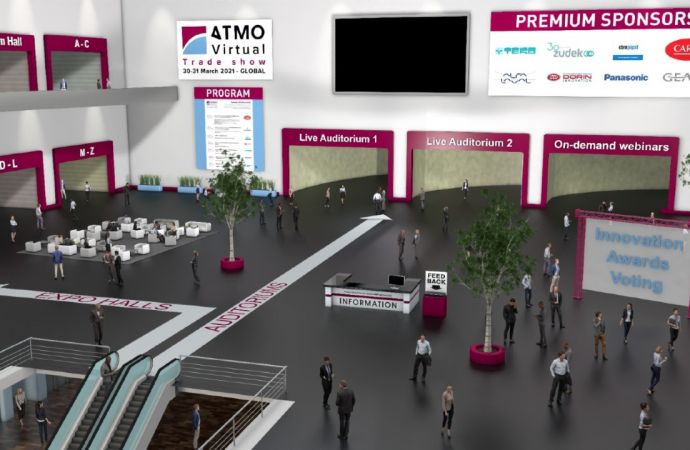At the 11th Gustav Lorentzen Conference in Hangzhou, China, several speakers from Danfoss presented their latest research on ammonia cold stores in China, safety in industrial ammonia systems and global market trends for ammonia and other natural refrigerants. Increased energy efficiency, reduced charge, safety and training were some of the major themes discussed throughout the presentations.

Increasing energy efficiency in Chinese cold stores
Over the past few years, China has experienced a rapid rise in the construction of large scale cold storage with industrial refrigeration systems, fueled by the need to improve food quality and safety and keep pace with economic development. However, this increase was not accompanied by the implementation of refrigeration best practices and many cold storage facilities, in which over 70% of the electrical energy is used for refrigeration, are now suffering from high energy bills. With China’s 12th Five-Year Plan, significant incentives are offered to facilitate the migration to more energy efficient industrial systems.
This was the backdrop of the presentation by Huang Zhihua from Danfoss Automatic Controls Management and Anatolii Mikhailov from Danfoss A/S: Possible solutions to improve energy efficiency for typical refrigeration control system in China cold storage. The presentation described a typical refrigeration control system in Chinese cold storage, which are controlled manually and typically use ammonia as the refrigerant. Their analysis of the energy consumption of cold stores in China and Europe highlighted large gaps between the common practices in China and Europe. Yet they affirmed that with knowledge and experience about control systems in industrial refrigeration systems, there is much potential for increasing energy efficiency in Chinese cold stores by transitioning directly to state of the art systems.
The authors concluded that optimisation of controls in industrial refrigeration systems offers a significant potential for energy savings in large cold storage applications. Areas of improvement include all key components of an industrial refrigeration system including condenser, evaporator and compressor. Calculations indicated the possibility for at least 20% savings compared with traditional solutions on the market today, meaning very short payback times for enhanced controls are possible.
Ensuring safety of industrial ammonia systems
In their paper The successful use of Ammonia systems in industrial applications, Niels P. Vestergaard and Torben Funder-Kristensen from Danfoss A/S highlighted that the need for ammonia refrigeration plants will grow due to an expanding cold chain coupled with the need for environmentally benign refrigerants. The paper discussed technology development and the precautions that must be considered when installing and running an ammonia plant, offering a suggested methodology for ensuring the best solutions, focusing on safety and energy efficiency.
Ammonia is an excellent and effective refrigerant; however, its toxicity must be addressed, carefully evaluating the system design and location. Over the last years, authorities in several countries have increased their focus on the topic and documented risk assessments of large systems located close to populated areas have become mandatory in many countries. This paper emphasised that it is necessary to focus on absolutely all safety aspects in the safety pyramid to ensure that best practice is implemented in all areas, ensuring a low overall risk for the complete system. Alternative methods, such as ammonia/CO2 cascade systems, that reduce charge will be important for meeting safety requirements for some systems, where enhanced safety requirements have to be followed.
Natural refrigerant market share to increase
Torben Funder-Kristensen and Asbjorn Leth Vonsild presented their paper Global Refrigerant Trends, which focused on where refrigerants, including natural refrigerants, are expected to gain market share moving forwards. As technology, regulations, standards, energy efficiency demands and training needs increase, the HVAC&R industry must prepare to meet these changes. The paper discusses scenarios in different regions in the context of the seven forces model, which was proposed at the 2012 Gustav Lorentzen Conference. The paper analysed three specific examples of natural refrigerant technologies, CO2, ammonia and hydrocarbons, in their main target applications and concluded that the feasibility of using natural refrigerants is increasing.
The authors compared an ammonia industrial system with CO2 cascade to large R134a and R22 systems. While industrial ammonia/CO2 systems have become a mature technology during the last eight years and will not experience the same incremental development as pure CO2 systems, they are becoming a very important solution for ammonia charge reduction using CO2 as a cold and heat carrier. These systems are commonly available in North America, Canada and the EU, and China is currently running pilot systems. The decreased ammonia charge in these systems minimises the risk of accidents in case of leakage, a very important consideration for older and not properly maintained ammonia plants close to residential areas.
A CO2 commercial multipack system with heat recovery was compared to similar R404A systems. The study showed that new system designs such as parallel compression improve the energy efficiency of CO2 systems. Heat recovery is also a well noted benefit when using CO2.
The paper also evaluated hydrocarbons in smaller systems, specifically small air conditioning systems and light commercial refrigeration compared to R22, R134a, R404A or R410A benchmark systems. The technologies are very similar to HFC technologies in regards to pressures, temperatures, etc., and their energy efficiency is either on par or better than HFC systems.
According to the authors, market readiness is the most critical barrier facing the introduction of natural refrigerant technologies and education and training of the existing service workforce are crucial to ensure safety and energy efficiency. They emphasise that the industry will need to focus on participating in national and regional frameworks to develop the market for the changes that will come.
About Danfoss
Operating in over 100 countries, Danfoss is a world leader in the research, development and production of high efficiency electronic and mechanical components and controls for air-conditioning, heating, refrigeration and motion control systems, as well as solutions for renewable energy technologies such as solar power. With a wide range of products, Danfoss offers solutions that combine innovative engineering with a commitment to energy efficiency and environmental responsibility.
Over the past few years, China has experienced a rapid rise in the construction of large scale cold storage with industrial refrigeration systems, fueled by the need to improve food quality and safety and keep pace with economic development. However, this increase was not accompanied by the implementation of refrigeration best practices and many cold storage facilities, in which over 70% of the electrical energy is used for refrigeration, are now suffering from high energy bills. With China’s 12th Five-Year Plan, significant incentives are offered to facilitate the migration to more energy efficient industrial systems.
This was the backdrop of the presentation by Huang Zhihua from Danfoss Automatic Controls Management and Anatolii Mikhailov from Danfoss A/S: Possible solutions to improve energy efficiency for typical refrigeration control system in China cold storage. The presentation described a typical refrigeration control system in Chinese cold storage, which are controlled manually and typically use ammonia as the refrigerant. Their analysis of the energy consumption of cold stores in China and Europe highlighted large gaps between the common practices in China and Europe. Yet they affirmed that with knowledge and experience about control systems in industrial refrigeration systems, there is much potential for increasing energy efficiency in Chinese cold stores by transitioning directly to state of the art systems.
The authors concluded that optimisation of controls in industrial refrigeration systems offers a significant potential for energy savings in large cold storage applications. Areas of improvement include all key components of an industrial refrigeration system including condenser, evaporator and compressor. Calculations indicated the possibility for at least 20% savings compared with traditional solutions on the market today, meaning very short payback times for enhanced controls are possible.
Ensuring safety of industrial ammonia systems
In their paper The successful use of Ammonia systems in industrial applications, Niels P. Vestergaard and Torben Funder-Kristensen from Danfoss A/S highlighted that the need for ammonia refrigeration plants will grow due to an expanding cold chain coupled with the need for environmentally benign refrigerants. The paper discussed technology development and the precautions that must be considered when installing and running an ammonia plant, offering a suggested methodology for ensuring the best solutions, focusing on safety and energy efficiency.
Ammonia is an excellent and effective refrigerant; however, its toxicity must be addressed, carefully evaluating the system design and location. Over the last years, authorities in several countries have increased their focus on the topic and documented risk assessments of large systems located close to populated areas have become mandatory in many countries. This paper emphasised that it is necessary to focus on absolutely all safety aspects in the safety pyramid to ensure that best practice is implemented in all areas, ensuring a low overall risk for the complete system. Alternative methods, such as ammonia/CO2 cascade systems, that reduce charge will be important for meeting safety requirements for some systems, where enhanced safety requirements have to be followed.
Natural refrigerant market share to increase
Torben Funder-Kristensen and Asbjorn Leth Vonsild presented their paper Global Refrigerant Trends, which focused on where refrigerants, including natural refrigerants, are expected to gain market share moving forwards. As technology, regulations, standards, energy efficiency demands and training needs increase, the HVAC&R industry must prepare to meet these changes. The paper discusses scenarios in different regions in the context of the seven forces model, which was proposed at the 2012 Gustav Lorentzen Conference. The paper analysed three specific examples of natural refrigerant technologies, CO2, ammonia and hydrocarbons, in their main target applications and concluded that the feasibility of using natural refrigerants is increasing.
The authors compared an ammonia industrial system with CO2 cascade to large R134a and R22 systems. While industrial ammonia/CO2 systems have become a mature technology during the last eight years and will not experience the same incremental development as pure CO2 systems, they are becoming a very important solution for ammonia charge reduction using CO2 as a cold and heat carrier. These systems are commonly available in North America, Canada and the EU, and China is currently running pilot systems. The decreased ammonia charge in these systems minimises the risk of accidents in case of leakage, a very important consideration for older and not properly maintained ammonia plants close to residential areas.
A CO2 commercial multipack system with heat recovery was compared to similar R404A systems. The study showed that new system designs such as parallel compression improve the energy efficiency of CO2 systems. Heat recovery is also a well noted benefit when using CO2.
The paper also evaluated hydrocarbons in smaller systems, specifically small air conditioning systems and light commercial refrigeration compared to R22, R134a, R404A or R410A benchmark systems. The technologies are very similar to HFC technologies in regards to pressures, temperatures, etc., and their energy efficiency is either on par or better than HFC systems.
According to the authors, market readiness is the most critical barrier facing the introduction of natural refrigerant technologies and education and training of the existing service workforce are crucial to ensure safety and energy efficiency. They emphasise that the industry will need to focus on participating in national and regional frameworks to develop the market for the changes that will come.
About Danfoss
Operating in over 100 countries, Danfoss is a world leader in the research, development and production of high efficiency electronic and mechanical components and controls for air-conditioning, heating, refrigeration and motion control systems, as well as solutions for renewable energy technologies such as solar power. With a wide range of products, Danfoss offers solutions that combine innovative engineering with a commitment to energy efficiency and environmental responsibility.
MORE INFORMATION
Related stories




